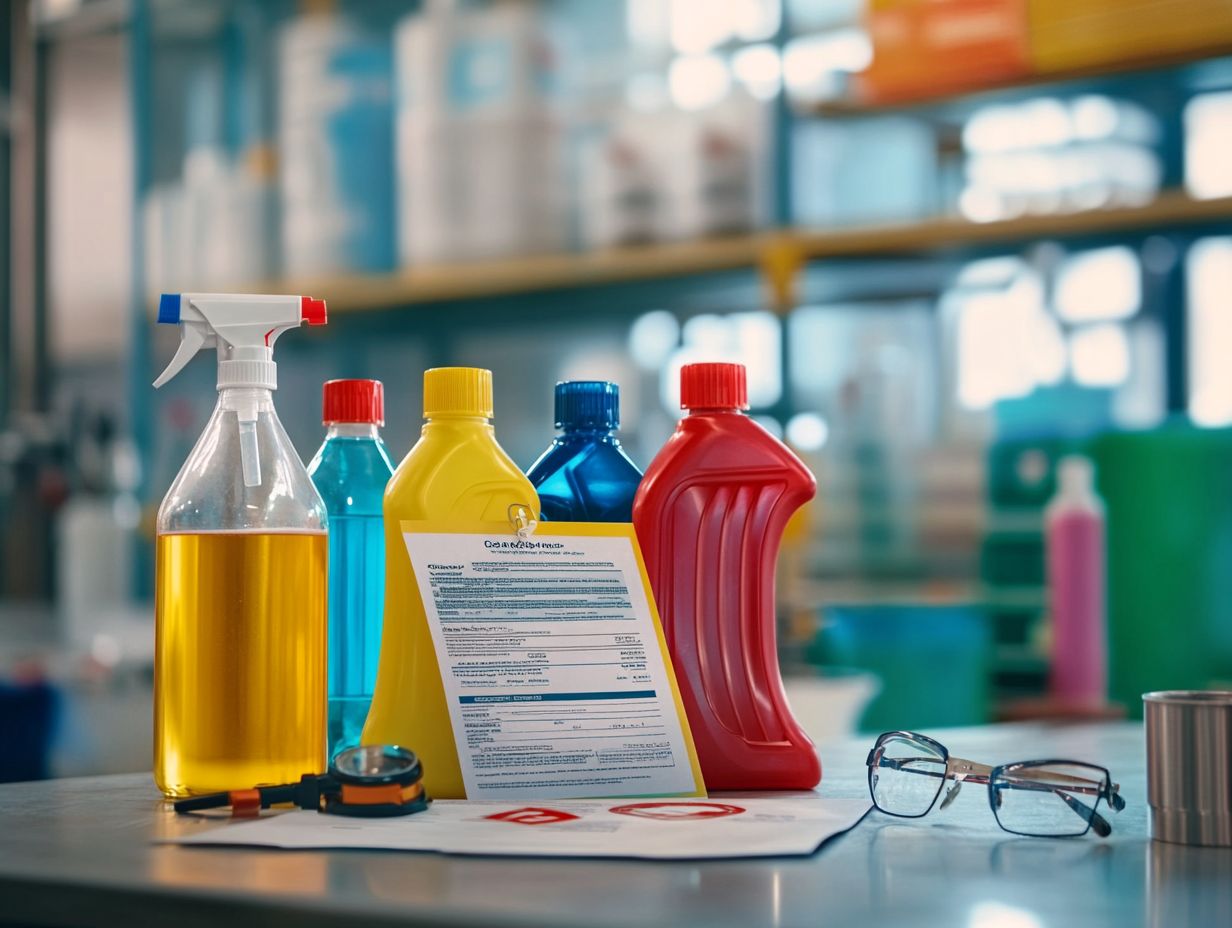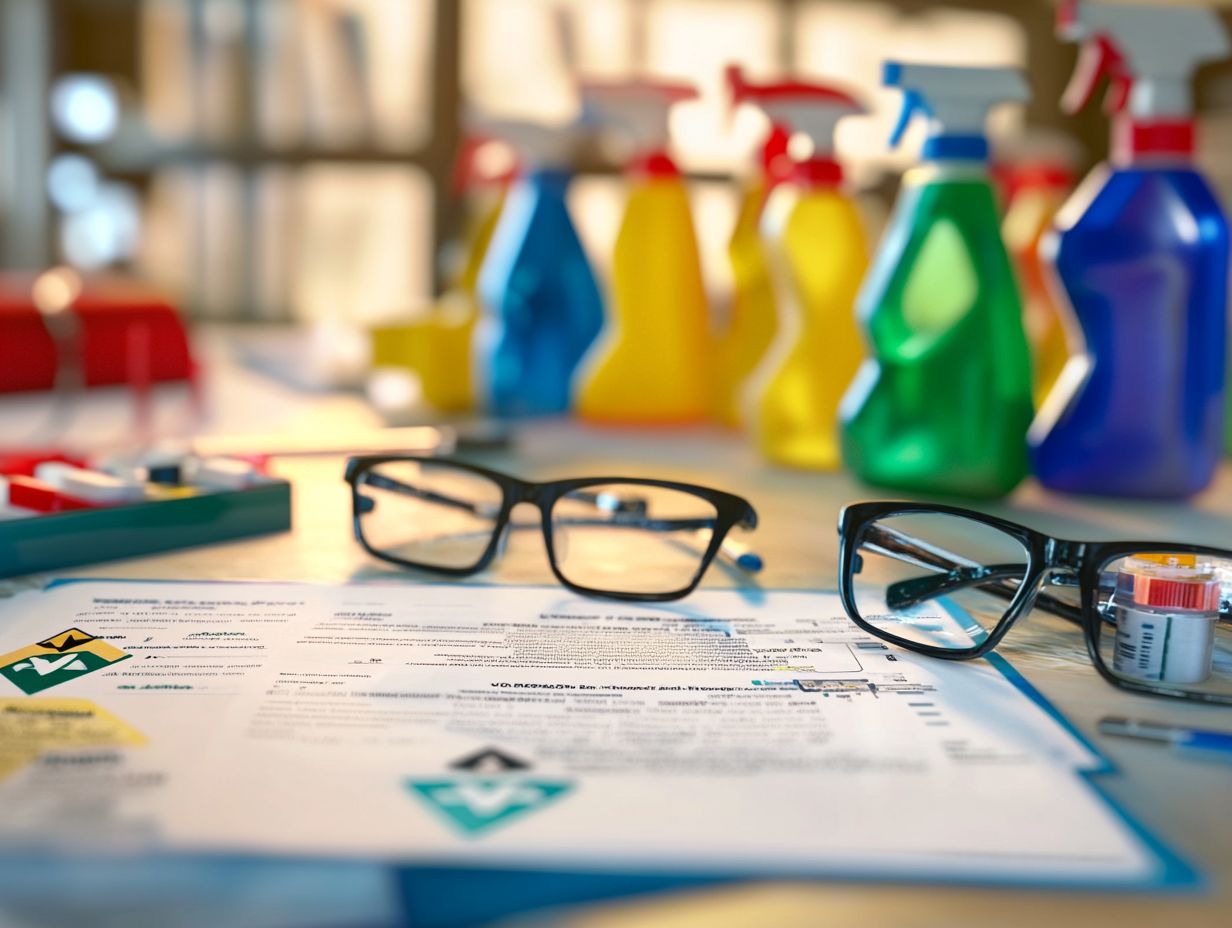Understanding Cleaning Product Safety Data Sheets
Safety Data Sheets (SDS) are indispensable documents that provide crucial insights into hazardous substances, particularly when it comes to cleaning products and disinfectants.
These sheets serve as an essential resource for ensuring the safe handling, storage, and emergency response related to chemicals. This article delves into the intricacies of safety data sheets, highlighting their significance and the comprehensive information they encompass from chemical identification and hazard assessment to disposal considerations and regulatory information.
By mastering how to read and interpret these sheets, you will be well-prepared to handle cleaning products, disinfectants, and other hazardous substances with the utmost safety and responsibility. Enhance your safety knowledge and empower yourself in the realm of chemical handling, exposure limits, and occupational safety.
Contents
- Key Takeaways:
- What Are Safety Data Sheets (SDS)?
- Why Are Safety Data Sheets Important?
- What Information Is Included in a Safety Data Sheet?
- 1. Identification
- 2. Hazard Identification
- 3. Composition/Information on Ingredients
- 4. First Aid Measures
- 5. Fire-Fighting Measures
- 6. Accidental Release Measures
- 7. Handling and Storage
- 8. Exposure Controls/Personal Protection
- 9. Physical and Chemical Properties
- 10. Stability and Reactivity
- 11. Toxicological Information
- 12. Ecological Information
- 13. Disposal Considerations
- 14. Transport Information
- 15. Regulatory Information
- 16. Other Information
- How to Read and Interpret Safety Data Sheets?
- Where Can You Find Safety Data Sheets?
- Are Safety Data Sheets Required for All Cleaning Products?
- What Are the Differences between Safety Data Sheets and Product Labels?
- Frequently Asked Questions
- What is a Material Safety Data Sheet (MSDS) and how does it differ from SDS?
- What are Safety Data Sheets (SDS) for cleaning products?
- Why is it important to understand SDS for cleaning products?
- What type of information is typically found in SDS for cleaning products?
- How can I access SDS for cleaning products?
- What should I do if I can’t find an SDS for a cleaning product?
- Do all cleaning products come with an SDS?
Key Takeaways:

- Master the use of SDS to protect your health and the environment by ensuring proper handling and safe use of cleaning products.
- Utilize SDS to access detailed information on ingredients, hazards, and handling procedures vital for safety.
- Prevent accidents, injuries, and environmental harm by properly interpreting and using SDS.
What Are Safety Data Sheets (SDS)?
Safety Data Sheets (SDS), once referred to as Material Safety Data Sheets (MSDS), are critical documents supplied by chemical manufacturers, providing vital information about hazardous materials. These sheets are crafted to safeguard both workers and the environment by detailing health effects, safe exposure levels, signal words, and proper handling procedures.
Under federal regulations, including OSHA and NIOSH guidelines, as well as standards like the Hazard Communication Standard and REACH, these documents must be readily accessible in any workplace utilizing hazardous substances. This ensures compliance with Right-to-Know laws and actively promotes a culture of safety in the workplace.
Why Are Safety Data Sheets Important?
Safety Data Sheets (SDS) are your frontline defense in ensuring chemical safety, particularly in environments where hazardous substances are managed. They offer vital insights into emergency procedures and outline the personal protective equipment (PPE) required for safe handling. Additionally, they present comprehensive risk assessments concerning chemical exposure, including details on chemical properties and toxicology information.
By guaranteeing that you and your colleagues have easy access to this critical information, SDS not only assist in meeting regulatory requirements but also enable healthcare professionals, union members, and safety managers to cultivate a secure working environment.
What Information Is Included in a Safety Data Sheet?
Safety Data Sheets (SDS) are a treasure trove of essential information vital for the safe handling of hazardous materials. Within these documents, you will find comprehensive details about health effects, emergency contact information in the event of chemical incidents, boiling points, vapor pressures, and clear signal words that indicate the levels of hazard.
The chemical classifications included will enlighten you about the nature of the substances you encounter. SDS provide crucial toxicology data, regulatory insights necessary for compliance, and ecological impact assessments designed to protect the environment. Trade secrets may also be included, where applicable.
Start mastering SDS today to ensure a safer workplace for everyone!
1. Identification
The identification section of a Safety Data Sheet (SDS) provides you with essential information about the chemical, such as its name, the manufacturer’s details, and the Chemical Abstracts Service (CAS) number, which uniquely identifies hazardous ingredients.
This section is crucial for ensuring that you can accurately recognize the substances you’re working with, enabling safe practices and well-considered choices. The CAS number acts as a universal identifier, cutting through any potential confusion that may arise from common names or alternative nomenclature, especially in global contexts where language differences might lead to misunderstandings.
Misidentification can lead to serious consequences, from improper storage to dangerous reactions. This underscores the importance of precision.
A clearly defined identification section serves as the cornerstone of safety protocols. It ensures that you are fully aware of the risks associated with hazardous materials at hand.
2. Hazard Identification
The hazard identification section describes potential dangers linked to the chemical, encompassing health hazards, environmental risks, and fire hazards. It employs signal words like ‘Danger’ or ‘Warning’ and incorporates pictograms, ensuring these risks are communicated effectively.
This essential section lays the groundwork for your understanding of the associated risks, empowering you to comprehend the severity of potential consequences. By skillfully utilizing signal words and impactful pictograms, it allows both seasoned professionals and casual users to swiftly recognize the level of threat posed by dangerous substances.
These elements convey safety concerns and help ensure proper handling and emergency procedures. Ultimately, this meticulous communication strategy underpins a safer working environment and nurtures a culture of health and environmental safety, significantly reducing the likelihood of accidents or mishaps.
3. Composition/Information on Ingredients
This section offers you comprehensive insights into the chemical’s composition, detailing the names and concentrations of hazardous ingredients along with their respective CAS numbers essential for identifying the materials at hand. In some cases, this section also includes stock solutions used in various industrial processes.
Grasping the chemical composition is vital, not only for following safety rules but also for safeguarding those who handle or may be exposed to these substances. Understanding the concentrations of hazardous ingredients empowers you to implement effective risk management strategies, thereby minimizing the potential for accidents, health-related issues, and environmental hazards.
Being aware of the specific chemicals involved empowers you to establish appropriate safety measures and training programs, ultimately cultivating a safer working environment. Maintaining accurate documentation and transparency regarding these compounds is crucial in promoting safety, compliance, and the responsible use of chemical substances.
4. First Aid Measures
When faced with exposure to hazardous materials, acting quickly and knowing the proper first aid steps can save lives!
The first aid measures section lays out the essential steps you need to take in the event of exposure to hazardous material, detailing the health effects and exposure limits that guide your response.
It’s essential to know the right first aid steps for different exposures. For example, if someone inhales the substance, moving them to fresh air and ensuring their breathing remains unobstructed are vital steps you should take. In cases of skin contact, it’s imperative to wash the affected area thoroughly with soap and water to eliminate any contaminants. If ingestion occurs, seeking immediate medical assistance is essential, particularly if the substance is toxic.
Prompt action in each of these scenarios not only alleviates discomfort but can also significantly minimize potential long-term health effects. This underscores the importance of being prepared for such emergencies and having well-defined first aid measures in place.
5. Fire-Fighting Measures

The fire-fighting measures section offers essential guidance on managing fire hazards related to the chemical. It details emergency procedures and the necessary safety gear you should use.
To effectively tackle potential fires, evaluate the specific properties of the chemical involved. Remember, different substances require specific actions. In some cases, using water for extinguishment may not be appropriate. Consider alternatives such as foam or dry chemical agents as part of your fire-fighting measures.
You must wear the right safety gear now to protect yourself from hazardous fumes and extreme temperatures. This includes flame-resistant clothing, safety goggles, and respiratory protection. Following established emergency procedures is critical. Doing so ensures your safety and mitigates the risk of escalation, ultimately protecting lives and property in the surrounding areas.
6. Accidental Release Measures
This section outlines essential procedures to follow in the event of an accidental release of dangerous materials. It provides detailed spill and emergency protocols designed to minimize both environmental and health impacts, including appropriate control measures.
Having clear spill procedures is paramount for any organization dealing with hazardous materials. It empowers you and your colleagues to respond swiftly and effectively when pressure mounts. In an emergency, your top priority should be to contain the spill, ensure the safety of all personnel, and prevent further environmental contamination.
Key steps to take include:
- Assessing the situation.
- Deploying absorbent materials.
- Notifying the appropriate emergency response team.
Regular training sessions are essential for equipping you with the skills and confidence to execute these procedures with precision. Understand your role during an incident to significantly enhance your organization s ability to manage spills efficiently, ultimately safeguarding both human health and the environment.
7. Handling and Storage
The handling and storage section outlines vital guidelines for the safe management of hazardous materials, emphasizing proper storage practices that help minimize the risks of accidents and exposure. This includes following handling storage guidelines set forth by regulatory bodies.
Best practices go beyond the standard recommendations found in the Safety Data Sheet (SDS) or the Material Safety Data Sheet (MSDS). Effective labeling of containers is essential, ensuring you can easily identify what s inside and the associated hazards.
An organized inventory management system is key. It helps keep track of the quantities of hazardous substances on-site and enables you to promptly spot expired materials that need disposal.
Regular safety inspections and adherence to safety guidelines are crucial for detecting potential leaks or deterioration in storage conditions. This allows you to take timely corrective measures. Use these practices to boost your safety measures and protect everyone at work!
8. Exposure Controls/Personal Protection
This section describes the essential personal protective equipment (PPE) and exposure controls you should implement to mitigate the risks associated with handling chemicals. It also outlines established exposure limits.
Choosing the right PPE is crucial for minimizing exposure in various scenarios. This might include gloves, goggles, face shields, and respirators. Depending on the specific chemical agents you’re dealing with, the recommended type of PPE will vary. For example, if you’re working with corrosive substances, you’ll need robust chemical-resistant gloves. Handling particulates may require specialized masks to prevent inhalation. PPE selection must be tailored specifically to the hazards present.
Exposure controls like ventilation systems significantly enhance safety by reducing airborne concentrations of hazardous substances. Adhering to established exposure limits is vital, as they are designed to protect health, prevent acute or chronic health effects, and create a safer working environment overall. By following these guidelines, you not only safeguard yourself but also foster a culture of occupational safety within your organization.
9. Physical and Chemical Properties
This section outlines the physical and chemical properties of the substance, including its boiling point, vapor pressure, and reactivity data. Understanding these details is crucial for knowing how the chemical behaves under various conditions.
Being well-informed about these properties is essential for ensuring safety during handling and usage. For example, knowing a substance’s boiling point allows you to determine the proper storage temperatures. Understanding vapor pressure data aids in evaluating potential hazardous exposures.
Grasping these factors enhances your ability to conduct comprehensive risk assessments. It also plays a pivotal role in effective emergency response planning. When unexpected incidents arise, your capacity to anticipate a substance’s behavior can significantly reduce risks. This ensures that the right containment and mitigation strategies can be implemented swiftly and effectively.
10. Stability and Reactivity
The stability and reactivity section provides essential insights into the chemical’s behavior under various conditions and its potential interactions with other substances.
Understanding these factors is crucial for fostering a safe work environment. Instability can lead to unexpected decompositions or hazardous reactions when exposed to heat, light, or moisture. Highly reactive substances can pose significant risks, reacting violently when even trace amounts of incompatible materials are present. Such reactions may result in explosions, toxic gas emissions, or fire. It is imperative to adhere strictly to safety protocols and implement proper storage methods.
Furthermore, understanding fire hazards and hazardous ingredients in the chemical can enhance safety. If you are handling these chemicals, it s vital to be well-informed about their properties to effectively mitigate incidents that could lead to injury or damage. This includes knowing the necessary emergency procedures and spill procedures.
11. Toxicological Information
This section offers essential toxicological information highlighting the health effects tied to exposure to the chemical. It details both symptoms of exposure and long-term health risks.
Understanding this information is vital for conducting an effective risk assessment. It helps you identify safe working conditions and implement necessary precautions. This knowledge equips management with awareness of potential hazards workers may encounter daily, supporting compliance with Right-to-Know laws and other regulations.
Be mindful of specific health effects, such as respiratory issues, skin irritations, and possible carcinogenic effects. Each of these can profoundly impact employee well-being. By adhering to established exposure limits, you can significantly reduce the risk of these adverse health outcomes. This fosters a safer work environment for everyone involved.
12. Ecological Information
The ecological information section evaluates the potential ecological impact of the chemical, including any environmental hazards it may pose to both aquatic and terrestrial ecosystems. This includes understanding the ecological impact as outlined by regulatory guidelines.
Understanding these impacts is crucial for your regulatory compliance, as it ensures that you are fully aware of the risks associated with chemical usage. This awareness directly shapes how you develop your handling and disposal practices, allowing you to minimize harm to the environment.
By adhering to ecological assessment guidelines, you can implement strategies that protect wildlife and preserve natural habitats. These assessments provide essential data that informs policy decisions and promotes sustainable practices, showcasing your commitment to environmental protection. This dedication not only enhances your company s reputation but also helps you fulfill your legal obligations under federal law and other regulations.
13. Disposal Considerations

This section emphasizes the importance of proper disposal considerations for hazardous chemicals, ensuring compliance with regulations that protect both human health and the environment. Following disposal considerations is critical to minimizing risks associated with environmental hazards.
Choosing the right disposal methods is crucial; after all, improper handling of hazardous waste can lead to severe consequences, such as soil and water contamination, which jeopardize ecosystems and public health. It s vital for you to recognize that local and federal guidelines are not simply recommendations they are legal requirements under federal law intended to mitigate these risks.
Engaging licensed disposal firms that specialize in hazardous waste is essential, as they guarantee that these materials are treated, recycled, or disposed of in facilities designed to handle such substances safely. This ensures compliance with regulations set forth by agencies such as the Environmental Protection Agency (EPA).
By adhering to these regulations, you not only build trust within the community but also contribute to a more sustainable environment for future generations.
14. Transport Information
The transport information section provides you with essential data on the safe transport of chemicals, ensuring compliance with regulations governing hazardous materials for secure handling during transit.
These regulations include crucial aspects such as labeling, packaging, and designated transportation routes, all of which are instrumental in protecting both the public and the environment. By grasping these components, you can significantly reduce the risk of spills, explosions, or other hazardous incidents, thus nurturing a culture of safety and compliance.
Understanding the specific guidelines relevant to the materials you are transporting enables you to implement best practices, minimizing liability and ensuring that emergency responders are well-prepared in the event of an accident.
15. Regulatory Information
This section presents essential regulatory information pertinent to the chemical, including the standards set forth by OSHA and other regulatory bodies. This ensures compliance with the laws governing hazardous materials. Guidance from agencies like NIOSH and the American Conference of Governmental Industrial Hygienists (ACGIH) is also vital.
Understanding these regulations is important for any business that handles potentially dangerous substances. Non-compliance can lead to serious repercussions, including hefty fines, legal challenges, and damage to your reputation. Familiarity with the Hazard Communication Standard and the Globally Harmonized System (GHS) a system that standardizes classification and labeling of chemicals globally is essential for ensuring compliance.
By adhering to these regulations, you protect your employees and the environment while enhancing operational efficiency and building trust among your stakeholders.
A key component in achieving compliance is the Safety Data Sheet (SDS), which is vital for fulfilling legal obligations. The SDS serves as a comprehensive resource providing crucial information about the properties of hazardous materials, safe handling procedures, and emergency response measures. This ensures that you stay informed and adequately prepared to manage risks effectively.
The Right-to-Know laws require employees to access these safety data sheets, ensuring everyone is informed.
16. Other Information
The other information section may encompass additional notes, trade secrets, or specifics pertinent to the chemical that don t fit neatly into previous categories. This can include information on chemical classifications and any signal words or pictograms used for chemical identification.
In this section, you ll discover essential safety guidelines, handling protocols, and storage recommendations designed to ensure compliance and safety across various environments. Proprietary information regarding the chemical’s unique formulation, chemical properties, or performance characteristics may also be included, offering valuable insights for both manufacturers and consumers.
This information is crucial for your success, as it gives you the power to use the chemical effectively while minimizing potential hazards. By having access to these critical details, such as exposure limits and control measures, you can make informed decisions that lead to optimal application and safer practices.
How to Read and Interpret Safety Data Sheets?
Reading and interpreting Safety Data Sheets (SDS) is paramount for ensuring safety in the workplace. These documents offer vital information about hazardous materials, chemical classifications, and the associated risks.
By grasping the structure of an SDS, you can swiftly find crucial details regarding hazard communication, first aid measures, personal protective equipment, and emergency procedures all of which play a significant role in fostering a safe working environment.
Where Can You Find Safety Data Sheets?
Act now to find Safety Data Sheets (SDS) from various sources! They are essential for your safety. You can locate them through chemical manufacturers, online databases, and workplace safety resources, ensuring that you have access to essential safety information.
By properly sourcing SDS, your organization empowers its workforce to manage hazardous materials safely while remaining compliant with federal law and regulations.
Are Safety Data Sheets Required for All Cleaning Products?
All cleaning products containing hazardous substances require Safety Data Sheets (SDS), as dictated by the stringent regulations surrounding chemical safety. This requirement guarantees immediate access to vital information about safe handling practices, potential health effects, chemical composition, and emergency procedures.
By ensuring you understand these details, you can manage risks effectively and maintain a secure environment while using these products.
What Are the Differences between Safety Data Sheets and Product Labels?
Safety Data Sheets (SDS) and product labels play distinct yet complementary roles in delivering crucial information about hazardous materials. Product labels offer immediate and concise insights into the risks associated with a product.
They provide guidelines for its safe handling. In contrast, SDS provide complete information necessary for ensuring proper compliance, including chemical identification, reactivity data, and effective safety management within your workplace.
Frequently Asked Questions

What is a Material Safety Data Sheet (MSDS) and how does it differ from SDS?
A Material Safety Data Sheet (MSDS) is an older format of a document that provides safety information about hazardous substances. It has been largely replaced by the Safety Data Sheet (SDS) format to align with the Globally Harmonized System (GHS) of classification and labeling of chemicals. Both serve to inform about chemical safety, but SDS follows a more standardized format.
What are Safety Data Sheets (SDS) for cleaning products?
Safety Data Sheets are documents that contain information about the potential hazards and safe handling procedures for cleaning products, such as disinfectants. They are created to provide guidance and safety information for individuals who use, store, or transport these products, ensuring compliance with Right-to-Know laws and other regulations.
Why is it important to understand SDS for cleaning products?
Knowing how to read an SDS can keep you safe and informed! Understanding SDS for cleaning products allows individuals to identify potential hazards associated with the product, such as fire hazards and health hazards, and take necessary precautions to ensure their safety. This information is vital during accidents or spills act quickly!
What type of information is typically found in SDS for cleaning products?
- Product’s ingredients
- Potential health hazards
- Emergency procedures
- Safe handling and storage practices
- First aid measures
- Toxicology information
- Disposal instructions
How can I access SDS for cleaning products?
Most manufacturers provide SDS for cleaning products on their websites or include them in the product packaging. They are also available from distributors or retailers. Some government agencies, such as the Environmental Protection Agency (EPA), may provide access to SDS databases. Visit manufacturer websites now to find SDS for your products!
What should I do if I can’t find an SDS for a cleaning product?
If you are unable to locate an SDS for a cleaning product, contact the manufacturer directly and request a copy. You can also reach out to the retailer or distributor from whom you purchased the product. In case of an emergency, contact your local poison control center for guidance, or refer to the emergency contacts listed on the SDS.
Do all cleaning products come with an SDS?
Not all cleaning products are required to have an SDS. Some products, such as consumer-grade household cleaners, may not fall under the jurisdiction of SDS regulations. However, it is always recommended to check for an SDS and follow the safety precautions outlined, even for products that do not require one. Consult the Health and Safety Professionals Guide for more information on when an SDS is necessary.






